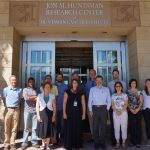Head and neck cancer (HNC) is a painful, disfiguring cancer of the mouth or throat that affects more than 50,000 people in the United States and 600,000 people worldwide each year. Recently, oral infection with human papillomavirus (HPV) has become the primary cause of HNC in North America and Europe. This epidemic affects people from every walk of life. Although HPV(+) HNC is sensitive to the intensive combination of surgery, radiation and/or chemotherapy, survivors commonly face permanent changes in uniquely human functions, including facial expression, swallowing, and voice. A national priority is the investigation of tailored, less aggressive treatments for HPV(+) HNC, where current approaches represent overtreatment. Progressive insight into the unique biology of HPV(+) HNC creates an unprecedented opportunity to develop HPV-selective therapies with fewer side effects.
Leading scientists at the University of Pittsburgh Cancer Institute (UPCI) recently demonstrated that HPV(+) cancers accumulate significantly fewer genetic mutations compared with HPV(-) cancers. Nonetheless, alterations of the gene PIK3CA, the master regulator of the PI3K cell growth pathway, are unusually common and represent the primary genetic changes in HPV(+) HNC. Overall, DNA changes that turn “on” the PI3K pathway are present in about half of HPV(+) HNC. Our collaborators have traced the importance of the PI3K pathway back to early HPV infection, where HPV directly activates the PI3K pathway to promote its own life cycle. In established cancers, PIK3CA alterations increase tumor growth. Moreover, PI3K-activated tumors obtained from HPV(+) HNC patients are very sensitive to novel drugs that inhibit PI3K, including the selective compound, BYL719.
Our collaborative network of outstanding clinicians and scientists brings together expertise in HNC clinical trial design (J. Bauman), HNC translational science (J Grandis), and HPV biology (M. Ozbun). We will test the idea that PI3K pathway activation, both directly by HPV oncoproteins, and indirectly through accumulated genetic changes in PIK3CA, drive benign HPV infections to transform into cancers. Detecting such PI3K pathway alterations in HPV(+) HNC may predict which patients will respond to BYL719, in the context of an innovative clinical trial. The trial will evaluate the addition of BYL719 to pre-operative chemotherapy in HPV(+) HNC, followed by minimally-invasive transoral robotic surgery, and risk-adapted radiation. We will perform comprehensive genetic and viral analysis of PI3K pathway alterations in treated patients, with particular focus on features that predict complete response. We expect that PI3K inhibitors will restore normal cell functions that can block cell growth, and render tumor cells more responsive to chemotherapy.
Results will provide insight into how PIK3CA mutations cooperate with HPV to transform normal cells into cancer, reveal new targets for the treatment of HPV(+) HNC, determine whether genetic PI3K pathway alterations predict response to PI3K inhibition, and establish a novel paradigm for more effective, less toxic therapy for people with HPV(+) HNC.














